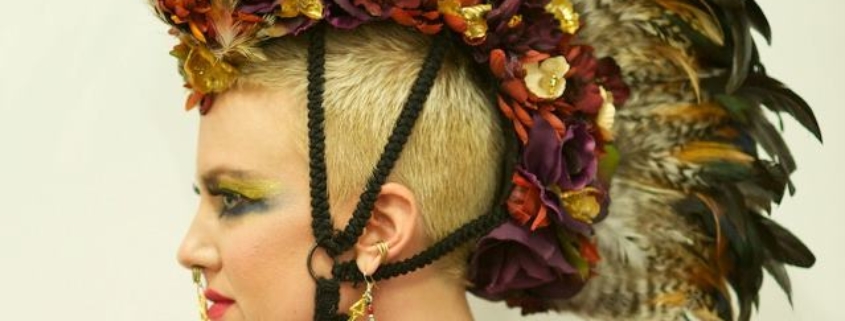Heart Connections: Into and Beyond the Particular
I recently gathered with a small group of friends to watch a documentary that was made two years ago about our friend Renee in her final months of life. Nine chairs were arranged in a half-circle to transform the Santa Monica office lobby where we met into a theater. On the lobby’s granite welcome desk by the basket of teabags, paper cups, and hot water kettle was a box of tissues. A serene painting of watery blues and greens was taken down so the wall behind it could be used as a projection screen. While we waited for two latecomers, someone passed around homemade doughnuts. We did not talk about Renee. Later, when the nine of us sat dabbing our eyes in the projection’s glow, I kept staring at the mounting hook we’d left in the wall. Here she was, two years after cancer, with a thirty pound picture hanger in her forehead. I wondered what she’d think of the memories we’d hung on her.
Renee lived with an open curiosity about other cultures and their methods of healing, and she gambled with her life to find out if they’d work. She lost, in the end, which means we all lost. By the time she started chemotherapy, her cancer was advanced, and from then on everything was a cocktail of radiation, chemo, medical marijuana, and, later, morphine. Despite this, when I think about Renee what I remember most immediately isn’t the cancer or the treatments, but her gratefulness and grace, and how I learned that a person can move through life and death—both—with a sense of wonder, and with fierce kindness. Even in the last months, she was concerned about others. But how are YOU? she would ask, interrupting the cancer talk. After she lost her hair, before she dyed it platinum and skulked cancer-chic across a fashion runway for the last time, she told me, Just before I was diagnosed, I had been looking for a new teacher. I believe that is why I have cancer. Yoga, meditation, nutrition—I studied them all deeply. It was time for me to find a new teacher.
The day before the nine of us sat together in that still lobby to watch a filmmaker’s collage of our friend, the most powerful earthquake in the region’s recent memory rocked Nepal. The wreckages from the quake, the aftershocks, the avalanches, and the difficulty of aid deliverance to isolated villages has the current death count near six thousand expected to rise beyond ten thousand. The horror of the news quickly filed itself neatly in my mind among other mass-horrors wreaked by the intersection of Mother Nature and human development: Hurricane Katrina, Haiti’s earthquake, Japan’s earthquake and tsunami; and those wrought by civil unrest: the Arab Spring, Central African Republic, too many to name.
At the risk of sounding ignorant, or worse, uncaring, that I group these events in a lump shows how little I truly know about them. So far, living here on the San Andreas Fault System for the past nine years, I am precariously privileged. I feel concern, sympathy, and worry for the people caught in these traumatic events, but my heart yearns for something more specific. Large numbers like “six thousand” awe me with their hugeness, but they are almost beyond my grasp. Thinking about villages like Langtang, which was entirely wiped out in the Nepal earthquake, is as unfathomable as the Hubble telescope photos of galaxies.
While watching the documentary interviews of Renee’s younger sister Rita, I realized that the particularness of individual stories is what helps my heart comprehend not just pain and suffering, but love and yearning, care and concern, desire, fear, hope. Even as relief efforts excavate through rubble and seek to reach remote areas, it is the tragedy of a singular person that I knew that has me tearing more tissues from the box. On the drive home after watching Renee’s documentary, I wondered if there was a young woman in Nepal whose body was fighting the same cancer at the moment the fault lines shifted. Was there a younger sister caring for her when the earth gave way? Had someone been praying for a new spiritual guide, and is now marveling with regret, Be careful what you wish for?
Lately I’ve been reading submissions for Lunch Ticket’s creative nonfiction team. It’s an honor to do this work. I believe there’s no greater teacher for a writer than the written word, and what I learn from the pieces I read is priceless. One thing I’ve noticed is that many very good submissions that we ultimately reject fall into two camps: the first tell a particular story about a particular person, the second tell a general story about an idea. Both often contain beautiful prose, delightful imagery, good intention. What many essays miss, however, is a recognition that the reader aspires to connect with the writer.
The essays in the first camp share the writer’s personal experience. They are often a memory of an experience, or a tribute to a loved one. I understand the need to write these stories down. I want to write about Renee, to document her, to preserve her. And yet, few readers of Lunch Ticket knew Renee; few will truly care to read my tribute. If I want an audience of anonymous strangers to read a story about Renee, I need to create a connection from my heart to the readers’. Renee is a person whom I loved, but just as she reached beyond the situation of her illness to find a deeper meaning, I need to write beyond my love for her to find a connection with you.
The essays in the second camp simply don’t get specific enough for the reader’s heart to truly comprehend. I heard this morning that a fifteen-year-old boy was found alive after being trapped for five days under rubble in Kathmandu. His face is in the paper; he could be my fourteen-year-old daughter’s classmate. He has a name—Pemba Tamang—, he worked at the hotel whose rubble he was buried in for those five days, he ate ghee to survive. I don’t mean to be dismissive or crass, but Pemba Tamang means more to me than the six thousand others. Already, with only three facts about the boy and a photo of his face, I worry for him, I care for his well-being, I wonder about his future and how these events will shape him, I think about his family. I have to remind myself that I don’t know him at all. I feel I already do.
There’s a strange alchemy that occurs when a writer tells a story in such a way that a reader can relate. If the devil’s in the details, the heart is too. Through a balance of detailed writing in exposition and scene, a good essay can bridge the chasm between strangers. The onus for building this connection is on the writer. It is the details of the writer’s specific circumstance, and the writer’s introspection about it, that creates the gold of creative nonfiction.







